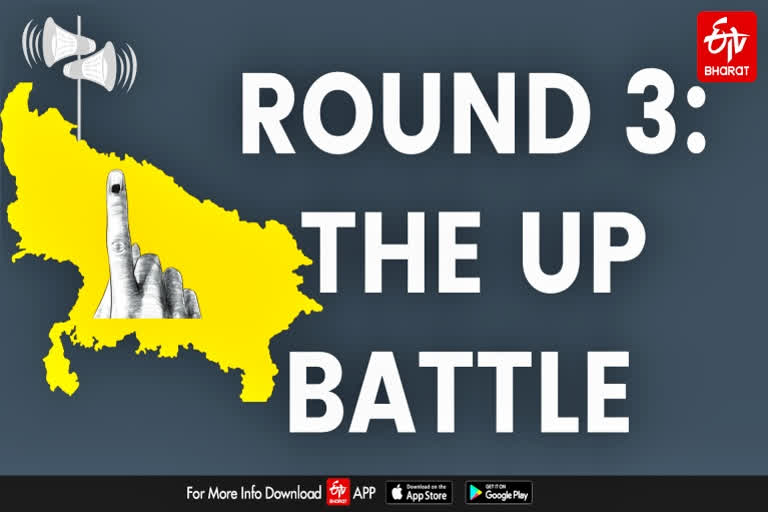A big lesson that one can draw from Sunday's third round of polling for the Uttar Pradesh assembly: In the remaining four phases, the contests are likely to turn more intense and the political discourse more acerbic. After Phase-three, 172 of the total UP assembly strength of 403 members have been accounted for. The other big shift is this: After Western UP's "Kamandal" (Communally charged) atmosphere, the UP campaign entered the "Mandal" (Social justice) phase beginning Round-three.
Phase-3 and the other remaining rounds are critical for both the ruling BJP, as also the Samajwadi Party — seen as the principal challenger. With ground reports suggesting that the BJP would be unable to retain its peak performance in the first two phases of Western UP, the BJP is apparently looking at consolidating its gains in the mainland areas. The SP, on the other hand, is making a big push to establish a lead.
Political discourse turns acerbic
Little wonder, therefore, that the tone and tenor of the political debate has turned sharp. Ahead of the Phase-3 poll, Prime Minister Narendra Modi said it was significant that terrorists in Gujarat had planted bombs on "bicycles" — which is the SP's election symbol. The same day, Defence Minister Rajnath Singh said at a rally in Gonda that the BJP had better claims on being the "real socialists" as against the fake socialism of the SP.
For its part, the SP drafted party patriarch Mulayam Singh Yadav into the poll campaign, who canvassed from his wheelchair during Phase 3. For the first time in years, the entire Yadav clan including Akhilesh, Shivpal and Dharmendra Yadav were seen together on stage — evidently to convey that the larger family had buried the hatchet.
The Yadav belt
In Phase 3 — comprising approximately 32 seats in what is called the "Yadav belt" apart from 13 seats of Bundelkhand and 14 of Kanpur rural and urban — the BJP had demolished the SP in its bastion — winning 49 of the 59 seats in 2017. The margin of victory in over a dozen seats had been more than 30,000. Therefore, the question: Even if the SP were to regain some of its lost ground, would it be able to establish the party's earlier dominance in the region?
Also read: Assembly Elections: The UP and Uttarakhand dynamics
The voting percentage in Phase 3 (at 60.18 percentage) has only been marginally less as compared to 2017, in keeping with the trends of the earlier two phases: A higher voting percentage in rural areas as compared to the urban centres. The region does not have a substantial presence of Muslim voters ( ranging between 7-12 percent), while the Yadav voters range between 10 -15 percent in districts including Etawah, Mainpuri, Etah, Farukhabad and Kannauj. The "Jats", who had been at the forefront of the farmers' struggle against the three farm laws — were also not an electoral factor in this phase. In order to establish a lead, the SP will need the support of a substantial third chunk of voters other than the Yadavs and the Muslims.
The demographic buffet
Phase 3 comprises a demographic buffet of non-Yadav OBCs including the Kurmis, Prajapatis, Shakyas, Mauryas and the Lodhs. In the Bundelkhand region — comprising districts such as Jhansi, Jalon, Lalitpur and Mahoba — the Scheduled Caste population is estimated at around 22 per cent. In the previous 2017 elections, the BJP had scored big, following the success of its social engineering strategy in attracting the non-Yadav OBC votes as also the non-Jatav votes of the Scheduled Castes. The BJP campaign centred on claims that the Yogi Adityanath government had been able to remove "fear" (better law and order) and "hunger" (providing free ration).
Reports indicate that while those at the lower rung of the caste hierarchy amongst the OBCs and SCs have remained loyal to the BJP, dominant and aspirational castes such as the Kurmis and Mauryas — besides the Yadavs — have moved away from the saffron party. Keshav Prasad Maurya of the Mahaan Dal — an alliance partner of the SP — is said to have a considerable influence in the area. The third phase was also a test for Swami Prasad Maurya, who recently resigned from the Yogi Adityanath government to join the SP coalition. But the question remains: Has the SP been able to broaden its support group amongst the non-Yadav OBCs and the non-Jatav Scheduled Caste voters?
Ground Reports
Ground reports suggest that the SP could make marginal gains in Bundelkhand; in which the BJP had won 13 of the 13 seats in 2017. In the 14 seats of Kanpur Urban and Rural, as also in the Yadav belt — also known as UP's potato belt — the contests are said to be tight between the BJP and the SP alliance. The long and short of this: Even if the BJP manages to retain its government in Lucknow, it is likely to do so with a much depleted strength in the assembly. This is the message emanating from Phase 3 polling.
Also read: Battle for UP: Campaign gets aggressive as reality sinks in
(Disclaimer: The opinions expressed in this article are that of the writer. The facts and opinions expressed here do not reflect the views of ETV Bharat.)



